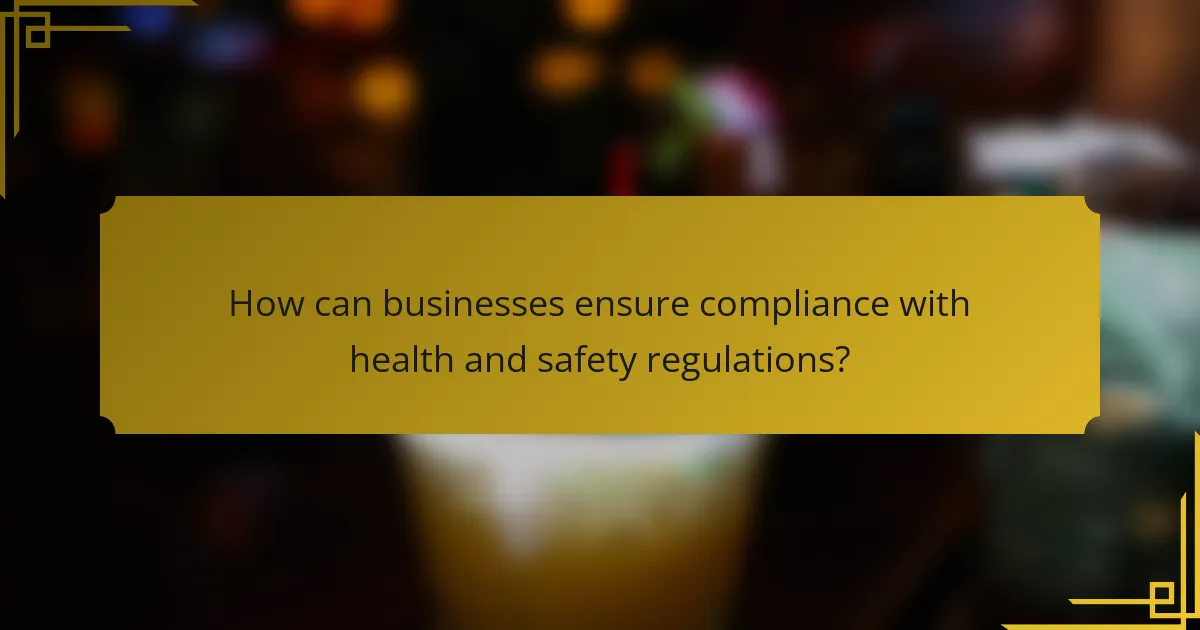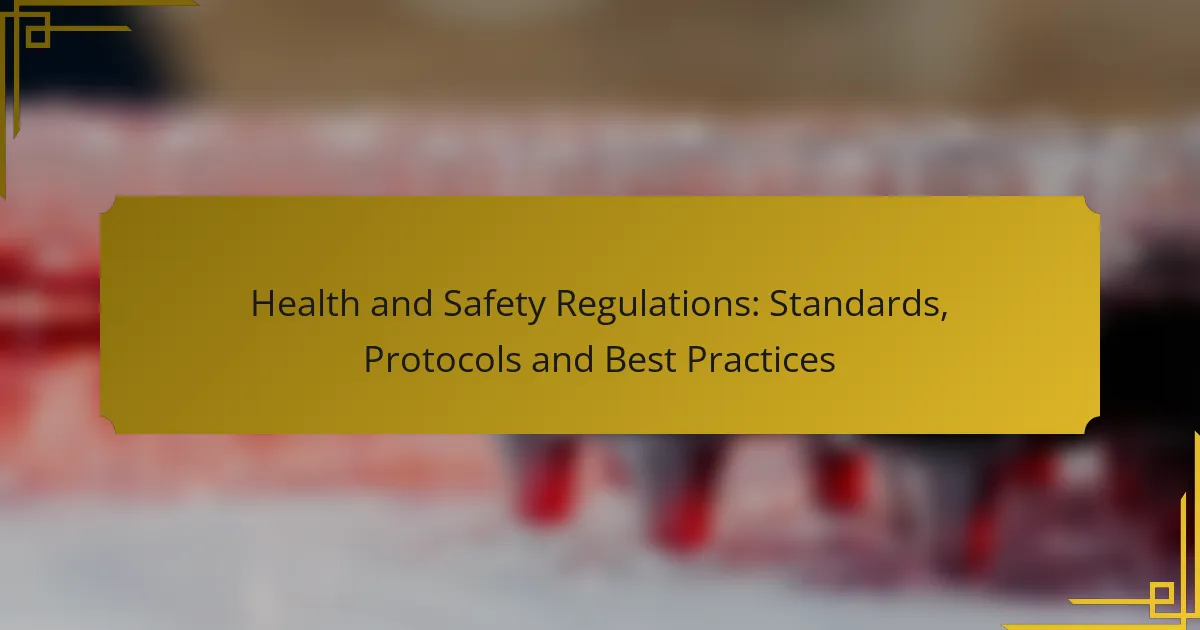Health and safety regulations play a crucial role in safeguarding workers and the environment by establishing mandatory standards that employers must adhere to. By implementing structured protocols, regular training, and effective monitoring, businesses can ensure compliance and cultivate a culture of safety. Adopting best practices such as conducting risk assessments and developing emergency preparedness plans further enhances workplace safety and employee well-being.

What are the key health and safety regulations in the United States?
The key health and safety regulations in the United States are designed to protect workers and the environment. These regulations are enforced by various federal agencies and set standards that employers must follow to ensure safe working conditions and minimize hazards.
Occupational Safety and Health Administration (OSHA) standards
OSHA standards are crucial for maintaining workplace safety across various industries. They cover a wide range of topics, including exposure limits to hazardous substances, safety protocols for machinery, and requirements for personal protective equipment (PPE).
Employers must comply with OSHA regulations to avoid penalties and ensure a safe working environment. Regular training and safety audits can help organizations stay compliant and reduce the risk of workplace accidents.
Environmental Protection Agency (EPA) regulations
The EPA regulations focus on protecting the environment and public health by controlling pollution and managing hazardous waste. These regulations require businesses to adhere to specific guidelines regarding emissions, waste disposal, and chemical handling.
Companies must implement environmental management systems to monitor compliance with EPA standards. Failure to comply can result in significant fines and legal repercussions, making it essential for businesses to stay informed about relevant regulations.
National Fire Protection Association (NFPA) codes
The NFPA codes provide guidelines for fire safety and prevention in various settings, including workplaces and residential buildings. These codes cover aspects such as fire alarms, sprinkler systems, and emergency exit routes.
Adhering to NFPA codes is vital for minimizing fire risks and ensuring the safety of occupants. Regular inspections and maintenance of fire safety equipment can help organizations comply with these codes and protect lives and property from fire hazards.

How can businesses ensure compliance with health and safety regulations?
Businesses can ensure compliance with health and safety regulations by implementing structured protocols, regular training, and effective monitoring systems. This proactive approach not only minimizes risks but also fosters a culture of safety within the organization.
Implementing regular training programs
Regular training programs are essential for keeping employees informed about health and safety regulations. These programs should cover topics such as emergency procedures, hazard recognition, and proper equipment usage. Aim for training sessions at least annually, with refresher courses more frequently for high-risk roles.
Consider using a mix of training methods, including hands-on workshops, online courses, and simulations. This variety helps cater to different learning styles and ensures that all employees grasp critical safety concepts effectively.
Conducting safety audits
Safety audits are systematic evaluations of workplace conditions and practices to ensure compliance with health and safety regulations. Conduct these audits at least once a year, or more often if significant changes occur in the workplace. Utilize checklists to cover all necessary aspects, including equipment safety, employee practices, and emergency preparedness.
Following the audit, create a report detailing findings and recommendations. Prioritize addressing any identified hazards promptly to maintain a safe working environment and reduce liability risks.
Utilizing compliance management software
Compliance management software streamlines the process of tracking and managing health and safety regulations. This technology can help businesses maintain documentation, schedule training, and monitor compliance status in real-time. Look for software that offers customizable features to fit the specific needs of your organization.
Additionally, ensure that the software provides reporting capabilities to easily analyze trends and identify areas for improvement. This data-driven approach can significantly enhance your compliance efforts and support a safer workplace.

What are the best practices for workplace safety?
The best practices for workplace safety involve creating a proactive environment that prioritizes employee well-being and minimizes hazards. Key strategies include fostering a safety culture, conducting regular risk assessments, and developing emergency preparedness plans.
Establishing a safety culture
Establishing a safety culture means integrating safety into every aspect of the workplace. This involves encouraging open communication about safety concerns and empowering employees to take ownership of their safety and that of their colleagues.
To foster this culture, management should lead by example, demonstrating commitment to safety protocols. Regular training sessions and safety meetings can reinforce the importance of safety and keep it at the forefront of employees’ minds.
Regular risk assessments
Regular risk assessments are essential for identifying potential hazards and mitigating risks before they lead to incidents. These assessments should be conducted at least annually, or more frequently if there are changes in the workplace or processes.
During a risk assessment, consider factors such as equipment safety, workplace layout, and employee behavior. Document findings and prioritize actions based on the level of risk, ensuring that high-risk areas are addressed promptly.
Emergency preparedness plans
Emergency preparedness plans outline the procedures to follow in case of an incident, such as a fire, natural disaster, or workplace violence. These plans should be comprehensive and tailored to the specific risks associated with the workplace.
Regular drills and training sessions are crucial to ensure that employees know their roles during an emergency. Review and update the plan periodically to incorporate lessons learned from drills and any changes in regulations or workplace conditions.

What are the consequences of non-compliance?
Non-compliance with health and safety regulations can lead to severe repercussions for organizations, including financial penalties, increased liability, and damage to reputation. Understanding these consequences is crucial for maintaining operational integrity and ensuring employee safety.
Fines and penalties from regulatory bodies
Regulatory bodies impose fines and penalties to enforce compliance with health and safety standards. These fines can vary significantly based on the severity of the violation, ranging from hundreds to thousands of dollars. For instance, a minor infraction might incur a few hundred dollars, while serious breaches could lead to penalties in the tens of thousands.
In addition to monetary fines, organizations may face additional costs related to legal fees and administrative expenses when contesting penalties. It is essential to stay informed about local regulations to avoid unexpected financial burdens.
Increased liability and insurance costs
Non-compliance can lead to increased liability for organizations, particularly if an incident occurs due to negligence. Companies may find themselves facing lawsuits from affected employees or clients, which can result in significant legal costs and settlements. This risk can escalate if the organization has a history of violations.
Moreover, insurance premiums often rise in response to non-compliance incidents. Insurers may view non-compliance as a higher risk, leading to increased costs for coverage. Regular audits and compliance checks can help mitigate these risks and keep insurance costs manageable.
Reputational damage
Failure to comply with health and safety regulations can severely damage an organization’s reputation. Negative publicity from incidents or regulatory actions can lead to loss of customer trust and business opportunities. In today’s digital age, news of non-compliance can spread quickly, affecting public perception.
To protect their reputation, organizations should prioritize compliance and actively communicate their commitment to health and safety. Engaging in transparent practices and demonstrating accountability can help rebuild trust and mitigate the long-term effects of any past violations.

What are the emerging trends in health and safety regulations?
Emerging trends in health and safety regulations focus on integrating technology, prioritizing mental health, and adapting to remote work environments. These trends reflect a shift towards more comprehensive and flexible safety protocols that address modern workplace challenges.
Integration of technology in safety protocols
The integration of technology in safety protocols enhances monitoring and compliance. Tools such as wearable devices, mobile applications, and AI-driven analytics help organizations track safety metrics in real-time, enabling quicker responses to potential hazards.
For example, companies can use apps to report incidents immediately, allowing for faster investigations and corrective actions. Additionally, virtual reality (VR) training programs can simulate hazardous situations, providing employees with hands-on experience without real-world risks.
Focus on mental health and well-being
There is a growing recognition of the importance of mental health in the workplace. Regulations are increasingly emphasizing the need for employers to provide resources and support for mental well-being, such as counseling services and stress management programs.
Organizations are encouraged to create a culture that prioritizes mental health, which can include regular check-ins, flexible work arrangements, and training for managers to recognize signs of mental distress. This proactive approach can lead to improved employee morale and productivity.
Increased emphasis on remote work safety
As remote work becomes more prevalent, safety regulations are adapting to address the unique challenges of home office environments. Employers are now responsible for ensuring that remote workspaces are safe and conducive to productivity.
This includes providing ergonomic assessments, ensuring proper equipment is available, and offering guidance on maintaining a healthy work-life balance. Companies should also establish clear communication channels for reporting safety concerns, even in remote settings.

How do international health and safety standards compare?
International health and safety standards vary significantly in their scope and application, impacting how organizations implement safety protocols. Key differences often arise from regional regulations, the specific industries involved, and the level of enforcement.
International Organization for Standardization (ISO) standards
ISO standards provide a framework for organizations to ensure safety and quality across various sectors. These standards, such as ISO 45001 for occupational health and safety management systems, help businesses identify hazards, assess risks, and implement effective controls.
Organizations seeking ISO certification must undergo a rigorous process that includes documentation, audits, and continuous improvement. Achieving ISO certification can enhance credibility and demonstrate a commitment to safety and quality to stakeholders.
European Union (EU) directives
EU directives set minimum health and safety requirements that member states must incorporate into national law. These directives, such as the Framework Directive 89/391/EEC, aim to protect workers by establishing baseline safety standards across industries.
Compliance with EU directives often involves risk assessments, employee training, and regular inspections. Companies operating in the EU must stay updated on these regulations to avoid penalties and ensure a safe working environment.
